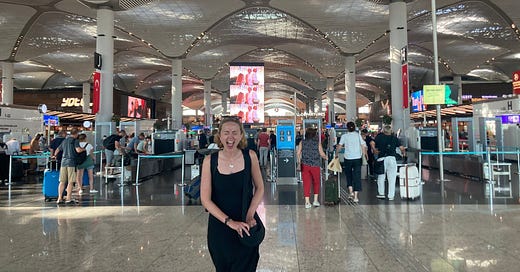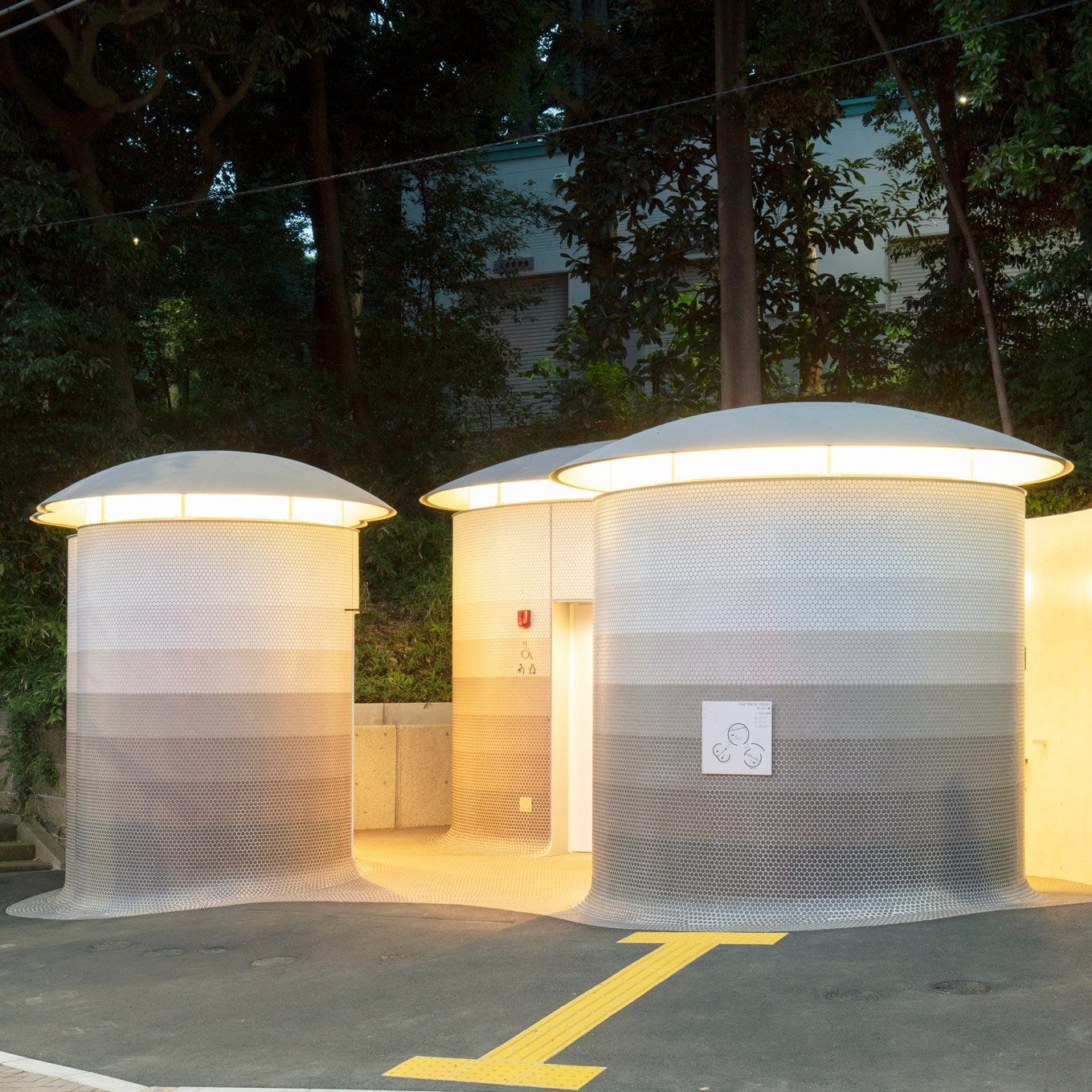Early summer has been a *wash out* (literally and metaphorically) and the GE campaign trail is (I would say) emotionally draining to follow with any intensity. Weirdly, I am looking forward to deep-diving manifestos this week, so hmu if you want to know anything about major political parties’ pledges!
Beyond politics and rain, I am a bit here there and everywhere at the moment. Mostly in a fun way. Sometimes in an exhausting way. We move! As always, I hope the below provides some vaguely interesting reading for train / tube / plane journeys in the coming weeks. Let me know your thoughts on the future of public toilets and what book you’d use to get people to talk to you 🙏
Books
Every so often, I hanker after a ridiculously long novel. I want to be swept away in 700 pages of other peoples’ lives, and boy does Collected Works deliver (AND it gets bonus points because it’s sexy Swedish lives). I feel like I’ve read different iterations of this novel before, but this one was pacy and quite funny and even though I am very much a warm weather kinda girl, it makes me sort of wish I was a multi-lingual Swedish student wrapped up on a freezing ferry ride looking out at the twinkling city lights over the icy North Sea?
A train cancellation gave me a spare hour at Edinburgh Waverley, and I decided I would treat myself to Douglas Stuart’s Young Mungo which broke my heart (in the best kind of way). I’m a glutton for punishment (at least in fiction terms), so if anyone has a copy of Shuggie Bain I can borrow, let me know because I hear it will break my heart all over again and I’m ready for it!!
I listened to this episode of Alison Roman’s Solicited Advice which features a big old discussion about picking the *right book* to take out for dinner if you’re eating by yourself to encourage people to start a conversation with you. Hand on heart I can say I’ve never chosen a book for a solo dinner with this in mind but I’m fascinated as to what people’s choice says about them, and what it says about the people who start up conversations with them based around said book choice. If you’ve done this, thoughts please! What did you choose and why?
make aesthetic infrastructure cool again!
My latest aesthetic and architectural obsession is THE TOKYO TOILET. Genuinely. It’s an amazing project (which I encountered watching Perfect Days), whereby 17 public toilets were commissioned by leading architects and designers to be installed across the Shibuyu district of Tokyo.
If you’ve never been to Japan, one of the first, and most fun differences you’re likely to encounter is the space-age toilets which most hotels, shopping centres and galleries/museums have. They come with a full remote control, which includes the ability to select a happy lift-music kinda noise to mask any offending sounds, water jets, heated seats, flushes - you name it, Japanese toilets have it. Very fun, very disconcerting if you press the wrong button. Perfect Days chronicles the days of Hirayama, a man who cleans these architecturally cutting edge toilets across Shibuya. It’s a beautiful film - one which reminds us of the joys of being mindful in our everyday lives - and Wenders captures a clean, elegant Tokyo aesthetic which I find incredibly soothing to watch.
The Tokyo Toilet project was commissioned originally in advance of Tokyo hosting the (postponed) 2020 Olympics, with the idea being that everyday necessities like public toilets can be about art and beauty as much as utility. I would highly recommend both watching Perfect Days, and/or spending a few minutes scrolling through this photo essay on THE TOKYO TOILET.
Can, or should, public infrastructure, facilities and building be beautiful? It’s a big question, and a fraught one. Beauty is, after all, subjective - it’s in the eye of the beholder. I would be the first to tell you I like nice design, and that I have quite a clear idea about what that means to me. A few years ago, gov.uk published a report called Living with Beauty which aimed to set out a manifesto for better quality building across the UK - particularly when it comes to housing. It came under quite a lot of criticism when it was published: not least because of the report’s tendency to associate ‘beauty’ in architecture with an idealised version of English architecture (looking at you, neo-Georgian influenced development in Stamford), and the obvious flaws around beauty and ugliness being inherently subjective.
The report does, of course, acknowledge that beauty and ugliness is often really about creating new developments which fit with an area’s local architectural character, and highlights several major flaws in the UK’s planning system. We’re obviously in the midst of a housing crisis - and indeed something of an infrastructure crisis, where decades of under-investment has left our basic public service infrastructure creaking and crumbling around us - but does the need to build more, build well, and build fast, negate the need for well-thought through, harmonious, attractive things? Spoiler: no.
Love ‘em or hate ‘em, the Victorians built lots of lovely pieces of London’s infrastructure and public spaces in a way which didn’t suggest that they literally hated the people who used them. Just because something’s functional, it doesn’t have to be horrific to look at. See, amongst many possible examples, the beautiful wrought-iron trusses of York station, the elegant tiled public loos across London, Crossness pumping station, Clifton Suspension Bridge etc. I’m by no means suggesting we entirely emulate the Victorians in their building habits or designs, but the principle is that you can think about the aesthetics of building rather than simply the function. Building well might cost marginally more, but it pays back in the long term. People care about building and landscapes that are beautiful. They behave better around them, and are more engaged with them. Victorian infrastructure has lasted so well in this country because of both the quality and the aesthetic of the design. Toilets are not glamorous, but they are important.
I was quite struck by a talk at the LRB a few weeks ago about London Feeds Itself - where Owen Hatherley spoke about the fact that he often ended up having to ask restaurants to use their toilets when he was out and about, because of the lack of public toilets in the city otherwise. Whilst the anecdote was relayed largely positively, it breaks my heart a bit to think how much we’ve neglected infrastructure and for so long, and what a detriment that is to us all. Obviously this is in part a direct reference to austerity + the Tories, but it’s also more broadly about forgetting the joy we should feel around infrastructure. It’s cool! It’s useful! I love public loos! I love train stations! I love public spaces! And I genuinely think we all do: a little bit of beauty as we go about our lives is so welcome: something that, every so often, makes you stop and smile.
Very excited (at this moment, anyway) to be at the monumental, light, airy Istanbul airport.
There’s a lot of economics around quantifying wellbeing, and indeed on the idea of ‘culture and heritage capital’, which I remain unconvinced by. As part of this though, Historic England produces research about proximity to heritage improving the quality of wellbeing and engagement with the space around them for ridiculously high numbers of people. Again, some of the wellbeing ‘data’ has to be taken with a pinch of salt, but more broadly, all of us deserve nice public spaces and creating them shouldn’t be a luxury. The Victorians weren’t exactly socialists (although the Moscow’s gorgeous metro stations are probs one of the few positive outcomes of Communism - fight me on this), and I actually don’t think politics is hugely relevant when it comes to design and building.
So, a long-winded way of saying: THE TOKYO TOILET is great, and maybe we should all take stock and be influenced by the fact that toilets can be super cool pieces of architecture and experiences that we can all enjoy and access (again, goes without saying there are plenty of reasons for our health, dignity and wellbeing public toilets are essential too). Celebrating infrastructure, not just for its function but also for its form, and making it actively, positively visible in our everyday lives is the way forward!
Toyo Ito’s trio of light-up mushroom loos in Tokyo. SO fun.
Etc
Time for another edition of things I have enjoyed in recent weeks!
- A glass of rose at Forza Taps at golden hour (sue me, I’m basic);
- This profile of Claudia Sheinbaum, the newly elected (and first female!) President of Mexico;
- Fudge doughnuts from Fisher & Donaldson;
- TABLE magazine (finger-lickingly delicious aesthetics);
- Politico’s great set of episodes ahead of the GE (this one on TV debates is particularly good);
- The achingly beautiful, romantic, melancholy animated depictions of Scotland in The Illusionist, which I watched snippets of at V&A Dundee and then immediately got home and watched the whole, lovely film all the way through;
- Cruise ship writing as a genre, but particularly (c/o Laura!) Crying Myself To Sleep On The Biggest Cruise Ship Ever; which in turn reminded me of the iconic My Eight Deranged Days on the Gone Girl Cruise;
- Mandy Payne’s prints and paintings of London’s brutalist architecture;
- Eating honey & cream for breakfast in Istanbul;
- An approximation of this zingy noodle salad;
- A really interesting, surprisingly nuanced piece from Grace Campbell on abortion in the Observer;
- Polldle, duh.
Over & out ✌🏼









Have never wanted to be approached when reading a book (lol), but most recently, I was when reading 1,000 Words and Woman of Light.